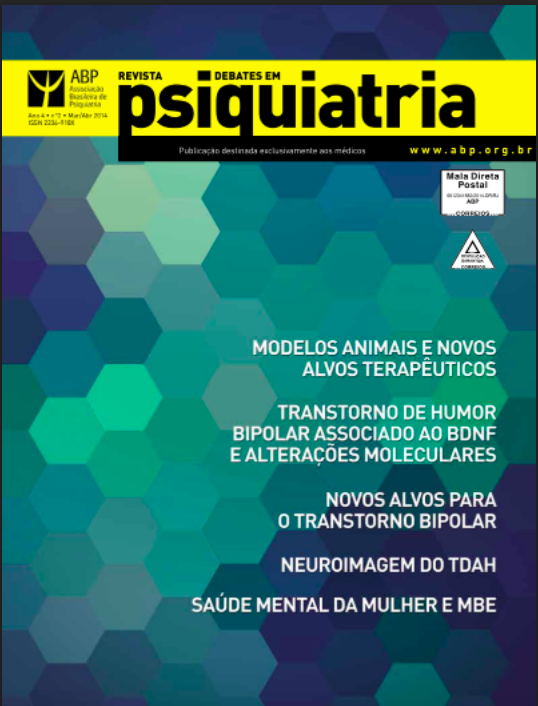Relação do transtorno de humor bipolar com o fator neurotrófico derivado do cérebro (BDNF) e alterações moleculares
DOI:
https://doi.org/10.25118/2236-918X-4-2-2Palavras-chave:
Transtorno de Humor Bipolar, Fator Neurotrófico Derivado do Cérebro (BDNF), Alterações Genéticas, PolimorfismosResumo
O Transtorno de Humor Bipolar (THB) é uma doença psiquiátrica crônica caracterizada por oscilações ou mudanças cíclicas de humor. Classificado em Tipo I (predomínio de episódios maníacos) forma mais severa da doença e o Tipo II (predomínio de episódios hipomaníacos). Possui origem multifatorial, incluindo influências ambientais, biológicas e genéticas acometendo cerca de 1% a 2 % da população geral. O objetivo deste estudo foi realizar uma revisão da literatura nas bases de dados eletrônicos abordando o transtorno de humor bipolar com o papel do Fator Neurotrófico Derivado do Cérebro (BDNF) e alterações moleculares. Devido ao elevado índice de pacientes acometidos e as diversas hipóteses estudadas por pesquisadores para elucidar os mecanismos envolvidos na doença, este estudo faz-se necessário a fim de contribuir na compreensão da mesma. Conclui-se, que embora haja diversos estudos relacionando polimorfismos à predisposição do THB a fisiopatologia da doença ainda não foi elucidada completamente, necessitando de pesquisas adicionais com o intuito de auxiliar na compreensão e progressão da mesma.
Downloads
Referências
Czepielewski L, Fillho LD, Brietzke E, Grassi-Oliveira R. Bipolar disorder and metabolic syndrome: a systematic review. Rev Bras Psiquiatr. 2013; 35:88-93
World Health Organization Who. The ICD10 classification of mental and behavioural disorders: clinical descriptions and diagnostic guidelines. Geneva, 2010.
Diagnostic and statistical manual of mental disorders DSM-IV, A.P.A. Washington, DC. 2000
APA: Associação Americana de Psicologia [acessado em 07.05.2013]. Available from: http://www.apa.org/topics/bipolar/index.aspx
Perito MES, Fortunato JJ. Marcadores Biológicos da Depressão: Uma Revisão Sobre a Expressão de Fatores Neurotróficos. Rev Neurocienc. 2012; 20(4):597-603
Levy B, Manove E. Functional Outcome in Bipolar Disorder: The Big Picture. Depression Research and Treatment. 2012; 12 pages
Thakker-Varia S, Alder J. Neuropeptides in depression: Role of VGF. Behavioural Brain Research. 2009; 197: 262–278
Del-Porto JA, Del-Porto KO. História da caracterização nosológica do transtorno bipolar. Rev. Psiq. Clín. 2005; 32: 7-14
Classificação Internacional De Doenças CID-10, O.M.D.S. 2008.
Almeida KM, Moreira CLRL, Lafer B. Metabolic Syndrome and Bipolar Disorder: What Should Psychiatrists Know?. CNS Neuroscience & Therapeutics. 2012;18:160–166
Proudfoot J, Doran J, Manicavasagar V, Parker G. The precipitants of manic/hypomanic episodes in the context of bipolardisorder: A review. Journal of Affective Disorders. 2011; 133:381–387
ABP: Associação Brasileira de Psiquiatria [acessado em 05.05.2013]. Available from: http://www.abp.org.br/portal/archive/12566
Equilibrium The Bipolar Foundation [acessado em 20.01.2013]. Available from:http://www.bipolar-foundation.org/bipolar-disorder/specific-populations/
Castelo M.S et al. Screening for bipolar disorder in the primary care: a Brazilian survey. J Affect Disord. 2012, 143: 118-24
Merikangas K, Jin R, Jian-Ping He, Kessler RC, Lee S, Sampson NA et al. Prevalence and Correlates of Bipolar Spectrum Disorder in the World Mental Health Survey Initiative. Arch Gen Psychiatry. 2011; 68: 241–251.
Barman SM. Introdução ao Sistema Nervoso. In: RAFF H, LEVITZKY M. Fisiologia Médica, uma aborgagem integrada. São Paulo: ARTMED. 2011; 105-115
Cunha C, Brambilla R,Thomas KL. A simple role for BDNF in learning and memory? Frontiers in Molecular Neuroscience. 2010; 3
Sebben AD, Cocolichio F, Schmitt APV, Curra MD, Silva PV, Tres GL et al. Efeito de fatores neurotróficos sobre o reparo de nervo periférico. Scientia Medica (Porto Alegre) 2011; 21:81-89
Fernandes BS, Gama CS, Ceresér KM, Yatham LN, Fries GR, Colpo G et al. Brain-derived neurotrophic factor as a state-marker of mood episodes in bipolar disorders: A systematic review and meta-regression analysis. Journal of Psychiatric Research. 2011; 995 e1004
Grande I, Fries GR, Kunz M, Kapczinski F. The Role of BDNF as a Mediator of Neuroplasticity in Bipolar Disorder. Psychiatry Investig 2010;7:243-250
Barbosa IG, Rocha NP, Huguet RB, Ferreira RA, Salgado JV, Carvalho LA et al. Executive dysfunction in euthymic bipolar disorder patients and its association with plasma biomarkers. Journal of Affective Disorders. 2012; 137:151–155
Barbosa IG,Rocha NP, Miranda AS, Huguet RB, Bauer ME,Reis HJ et al. Increased BDNF levels in long-term bipolar disorder patients. Rev Bras Psiquiatr. 013;35:067-069
Karege F, Bondolfi G, Gervasoni N, Schwald M, Aubry JM, Bertschy G. Low Brain-Derived Neurotrophic Factor (BDNF) Levels in Serum of Depressed Patients Probably Results from Lowered Platelet BDNF Release Unrelated to Platelet Reactivity. BIOL PSYCHIATRY 2005;57:1068–1072
Yuluga B, Ozan E, Gonulo AS, Kilic E. Brain-derived neurotrophic factor, stress and depression: A minireview. Brain Research Bulletin. 2009; 78: 267–269
Aan M, Mathew SJ, Charney DS. Neurobiological mechanisms in major depressive disorder. Cmaj. 2009 Feb; 180: 305-13
Kauer-Sant’Anna M, Kapczinski F, Andreazza AC, Bond DJ, Lam RW, Young T, Yatham LN. Brain-derived neurotrophic factor and inflammatory markers in patients with early- vs. late-stage bipolar disorder. International Journal of Neuropsychopharmacology. 2009; 12: 447–458.
Gama CS, Kunz M, Magalhães PVS, Kapczinski F. Staging and neuroprogression in bipolar disorder: a systematicreview of the literature. Rev Bras Psiquiatr. 2013;35:70-74
Magalhaes PV, Jansen K, Pinheiro RT, Klamt F, Teixeira AL, Da Silva RA et al. Systemic toxicity in early-stage mood disorders. J Psychiatr Res.2011;45:1407-9.
Magalhães PVS, Fries GR, Kapczinski F. Marcadores perifericos e a fisiopatologia do transtorno bipolar. Rev Psiq Clín. 2012;39:60-7
Tramontina JF, Andreazza AC, Kauer-Sant’Anna M, Stertz L, Goi J, Chiarani F et al. Brain-derived neurotrophic factor serum levels before and after treatment for acute mania. Neuroscience Letters. 2009; 452:111–113
Kenna GA, Roder-Hanna N, Leggio L, Zywiak WH, Clifford J, Edwards S et al. Association of the 5-HTT gene-linked promoter region (5-HTTLPR) polymorphism with psychiatric disorders: review of psychopathology and pharmacotherapy. Pharmacogenomics and Personalized Medicine. 2012; 5: 19–35
Michelon L, Vallada H. Genética do transtorno bipolar. Rev Bras Psiquiatr. 2004; 26:12-6
Andreazza AC, Young LT. The neurobiology of bipolar disorder: identifying targets for specific agents and synergies for combination treatment. International Journal of Neuropsychopharmacology. 2013; 1:14
Tramontina JF, Miranda DM, Filho HCS, Romano-Silva MA. Genética e transtorno bipolar. In: Kapczinski F, Quevedo J. Transtorno Bipolar e teórica clínica. São Paulo: ARTMED. 2009; 61-74
Egan MF, Kojima M, Callicott JH, Goldberg TE, Kolachana BS, Bertolino A et al. The BDNF val66met Polymorphism Affects Activity-Dependent Secretion of BDNF and Human Memory and Hippocampal Function. Cell. 2003 Jan; 112: 257–269
Teh CA, Lee TS, Kuchibhatla M, Ashley-Koch A, MacFall J, Krishnan R et al. Bipolar Disorder, Brain-Derived Neurotrophic Factor (BDNF) Val66Met Polymorphism and Brain Morphology. PLoS ONE. 2012; 7:38469
Mercedes Z´ R, Ricardo D´ V, Nieves B, Aurora A, Biotza G, Marı´a I. Z et al. Catechol O-methyltransferase and monoamine oxidase A genotypes, and plasma catecholamine metabolites in bipolar and schizophrenic patients. Neurochemistry International. 2010, 56:774–779
Virit O, Erdal ME, Savas HA, Barlas O, Yumru M, Gokdogan T et al. Catechol-O-methyltransferase gene Val108/158Met polymorphism in bipolar disorder. Neurology, Psychiatry and Brain Research. 2011; 1 7:4 6 –50
Nishioka AS, Perin EA, Sampaio AS, Cordeiro Q, Cappi C, Mastrorosa RS et al. O papel do polimorfismo funcional VNTR da regiao promotora do gene MAOA nos transtornos psiquiátricos. Rev Psiq Clín. 2011; 38:34-42
Caspi A, Hariri AR, Holmes A, Uher R, Moffitt TE. Genetic Sensitivity to the Environment: The Case of the Serotonin Transporter Gene and Its Implications for Studying Complex Diseases and Traits. Am J Psychiatry 2010; 167:509–527
Neves FS, Malloy-Diniz LF, Romano-Silva MA, Aguiar GC, Matos LO, Correa H. Is the serotonin transporter polymorphism (5-HTTLPR) a potential marker for suicidal behavior in bipolar disorder patients?. Journal of Affective Disorders. 2010; 125:98–102
Li D, He L. Meta-analysis supports association between serotonin transporter (5-HTT) and suicidal behavior. Molecular Psychiatry. 2007; 12:47–54
Hauser J, Leszczynska A, Samochowiec J, Czerski PM, Ostapowicz A, Chlopocka M et al. Association analysis of the insertion/deletion polymorphism in serotonin transporter gene in patients with affective disorder. Eur Psychiatry. 2003 May;18:129-32.
Rybakowski JK. Genetic Influences on Response to Mood Stabilizers in Bipolar Disorder. CNS Drugs. 2013; 27:165–173
Rybakowski JK, Suwalska A, Czerski PM, Dmitrzak-Weglarz M, Leszczynska-Rodziewicz A, Hauser J. Prophylactic effect of lithium in bipolar affective illness may be related to serotonin transporter genotype. Pharmacol Rep. 2005; 57:124-7
Dwivedi Y, Pandey GN. Adenylyl cyclase-cyclicAMP signaling in mood disorders: Role of the crucial phosphorylating enzyme protein kinase A. Neuropsychiatric Disease and Treatment 2008; 4:161–176
Mamdani F; Alda M; Grof P; Young LT, Rouleau G, Turecki G. Lithium Response and Genetic Variation in the CREB Family of Genes. Am J Med Genet B Neuropsychiatr Genet. 2008 June 5; 147B: 500–504.
McDonald ML, MacMullen C, Liu DJ, Leal SM, Davis RL.Genetic association of cyclic AMP signaling genes with bipolar disorder. Transl Psychiatry. 2012 ; 2;2:e169.
Downloads
Publicado
Como Citar
Edição
Seção
Licença

Este trabalho está licenciado sob uma licença Creative Commons Attribution-NonCommercial 4.0 International License.
Debates em Psiquiatria permite que o (s) autor (es) mantenha(m) seus direitos autorais sem restrições. Atribuição-NãoComercial 4.0 Internacional (CC BY-NC 4.0) - Debates em Psiquiatria é regida pela licença CC-BY-NC
































